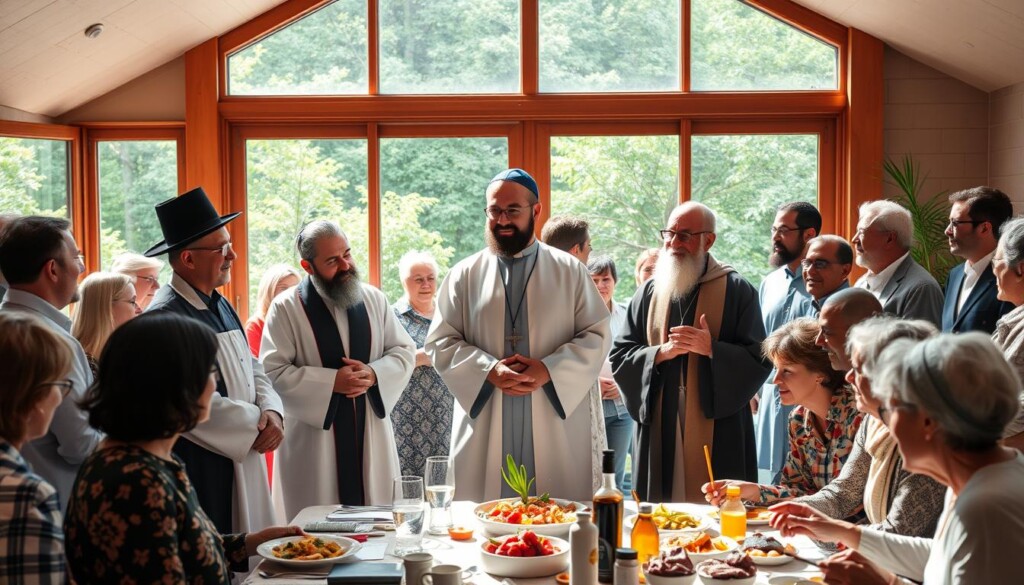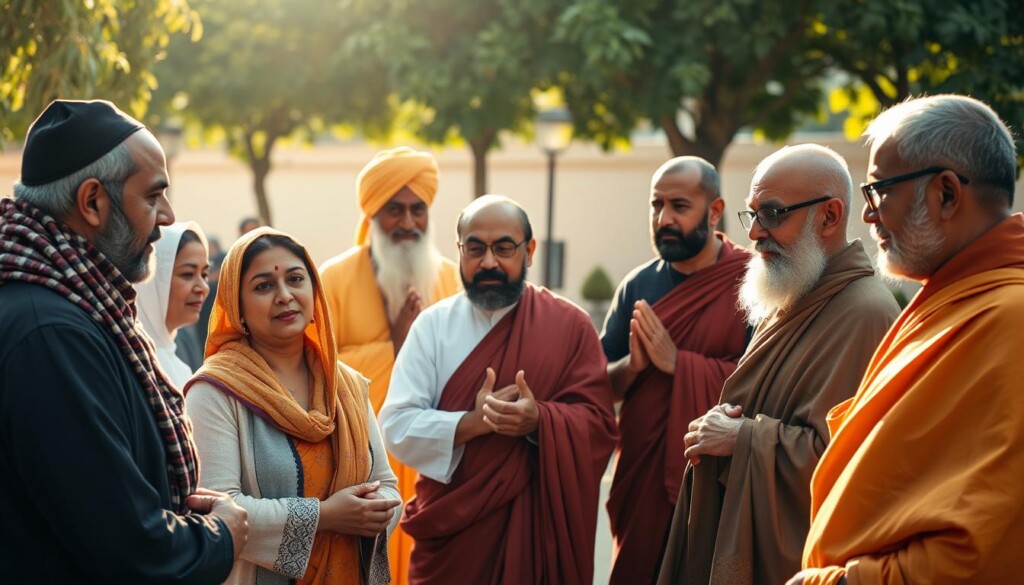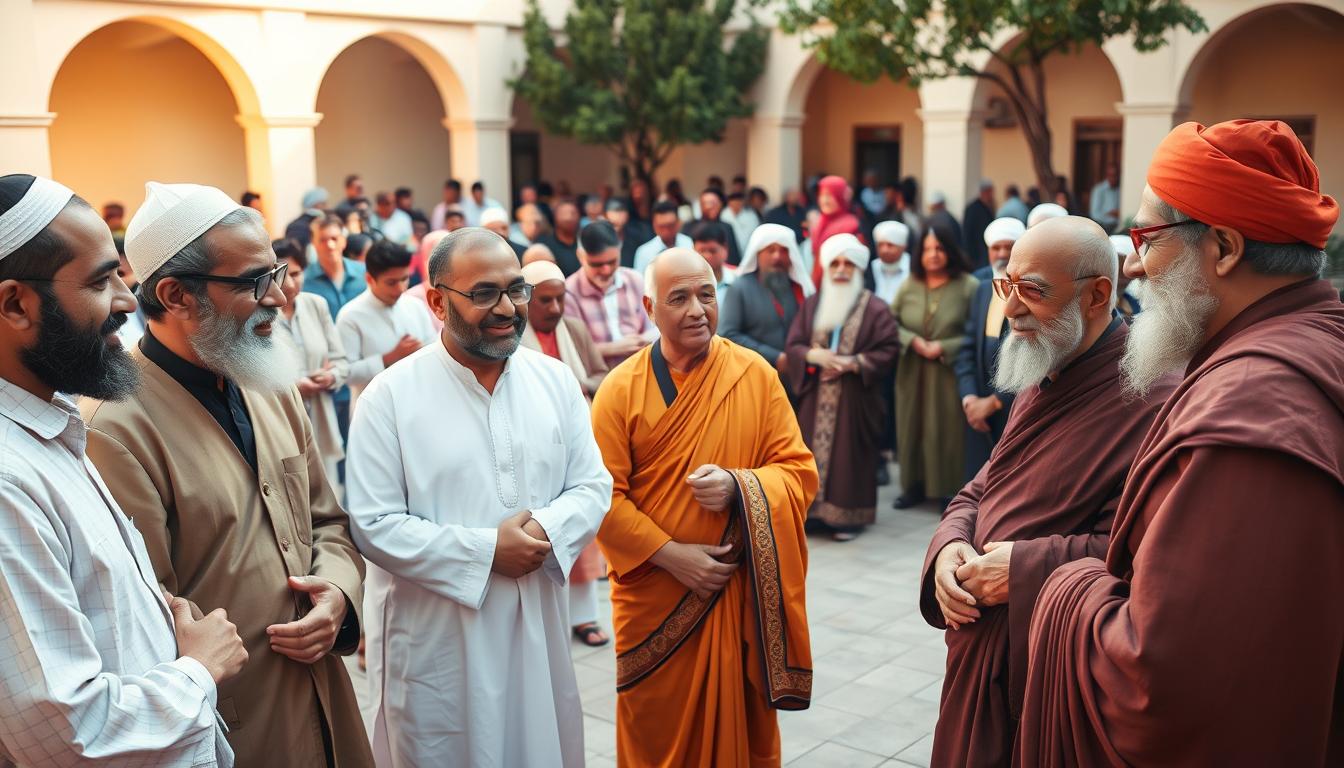How can interfaith groups help break down barriers in a world often split by faith? This question leads us to see the important role these groups play. They help bring people together by starting conversations, working together, and organizing events that connect different faiths.
In a time when faiths are more diverse and divided, their work is more important than ever. They help create a sense of unity and get people involved in their communities.
Key Takeaways
- Interfaith organizations play a key role in promoting faith diversity.
- They help start conversations to understand each other better.
- These groups lead initiatives to get communities involved.
- They are key in bringing people from different cultures together.
- Interfaith efforts are more important than ever to fight division.
Understanding Interfaith Organizations
Interfaith organizations are key in promoting religious tolerance. They help people from different faiths connect. These groups work together on social issues, breaking down religious barriers.
Definition and Purpose
These organizations aim to build understanding and relationships among religions. They bring people of different faiths together to achieve common goals. This helps everyone grow and fosters harmony among diverse groups.
Historical Context
The idea of interfaith movements started in the early 20th century. It was to solve religious conflicts and promote peace. Events like the Chicago Parliament of Religions in 1893 were key. They set the stage for ongoing dialogue and unity among religions.
Importance in Modern Society
In today’s America, interfaith groups are essential. They fight against prejudice and political divisions. They create spaces for dialogue, promoting religious tolerance.
Through programs on discrimination, community service, and social justice, they help build inclusive societies. Here, all beliefs are respected and valued.
Notable Interfaith Organizations in the USA
Many organizations in the USA are working hard for religious harmony. They show how different faiths can come together for peace and understanding. Here are some key groups leading the way in dialogue and interfaith efforts.
The Interfaith Alliance
The Interfaith Alliance fights for religious freedom and respects all faiths. They push for policies that celebrate our diverse beliefs. Their work helps build respect and understanding among different religious groups.
United Religions Initiative
The United Religions Initiative aims to stop violence caused by religion worldwide. They work in over 108 countries, bringing together religious leaders for peace. Their efforts help create harmony and connect communities globally.
Faiths United to Prevent Gun Violence
This group unites faiths to fight gun violence through advocacy and education. Faiths United shows how different religions can work together for change. They prove that diverse faiths can unite for a common goal.
How Interfaith Organizations Foster Community
Interfaith organizations are key in bringing people together. They help different religious groups connect. By starting conversations, helping out in the community, and teaching about faiths, they build a stronger community.
Promoting Dialogue and Understanding
Interfaith groups host workshops and panels. These events spark deep talks about different beliefs. They help people respect and understand each other better, which is essential for living together peacefully.
Collaborative Community Service Projects
Interfaith projects often bring together people from different faiths. They work together on community service. This builds friendships and teaches empathy, showing the value of teamwork for the greater good.
Educational Initiatives
Interfaith groups offer educational programs. These teach people about various faiths. This knowledge helps break down barriers and builds a more welcoming community.
The Role of Technology in Interfaith Engagement
Technology is key in improving interfaith talks, thanks to virtual platforms. These tools help groups connect, talk, and share ideas across the world.
Virtual Events and Online Platforms
Virtual events have changed how groups meet and talk. Webinars and online meetings let people join in who can’t be there in person. This makes sure everyone’s voice is heard and adds to the spirit of working together.
Social Media and Outreach
Social media is a big help for groups wanting to reach more people. Sites like Facebook, Twitter, and Instagram let them share messages of unity and show off their work. It’s a great way to connect with younger folks and build a community based on understanding and respect.
Digital Resources for Further Engagement
Groups are using digital tools to share learning materials about different faiths. These materials are easy to find and come in many forms, like articles, videos, and games. This helps people learn more about faith, culture, and spirituality, leading to better and more respectful talks between different religions.

LocalZ: Connecting Communities Through Faith
LocalZ is a key platform for boosting community ties through faith. It connects people with local services, helping build relationships between individuals and businesses. LocalZ’s goal is to strengthen community networks, promote interfaith dialogue, and support local economies.
Overview of LocalZ’s Mission
LocalZ’s main mission is to create strong community bonds. It offers a directory of local services to help people and businesses connect. This mission highlights faith as a common thread, enriching community life.
Engaging Local Businesses and Organizations
LocalZ works with local businesses and groups to promote their services. This effort boosts businesses and creates economic growth, strengthening community ties. It helps foster a sense of cooperation among residents and businesses.
Supporting Interfaith Initiatives
LocalZ is dedicated to community wellbeing, giving 50% of its fees to community groups. This support goes to interfaith projects, promoting multicultural cooperation. It shows the value of community engagement and supports local interfaith efforts. To learn more, visit our website.
Success Stories: Interfaith Organizations in Action
Interfaith groups are key in building communities. They help people from different faiths understand and work together. In the U.S., many neighborhoods have started interfaith programs. These efforts have brought people together, reducing conflicts.
Case Study: Community Building in Diverse Neighborhoods
Many neighborhoods have welcomed interfaith programs. This has improved how people get along and built stronger bonds. These programs have changed local areas for the better, making them places of cooperation and respect.
Successful Interfaith Events
Many interfaith events have brought people from different faiths together. Events like dinners, cultural fairs, and forums are great for sharing and learning. They show how working together can build understanding and respect.
Testimonials from Participants
People who take part in interfaith activities say it changes their lives. They make friends across religious lines. Their stories show how important it is to build communities through interfaith work.

Challenges Faced by Interfaith Organizations
Interfaith groups face many challenges that affect their work. They need a smart plan to deal with these issues, like understanding different religions. They also struggle with not having enough resources to reach out and talk to more people.
Navigating Religious Differences
Beliefs can cause problems unless everyone talks and respects each other. Groups must make spaces where people can share their faith. This way, everyone’s beliefs are valued, helping to build strong relationships.
Funding and Resource Limitations
Getting enough money is a big problem for these organizations. They can’t do as much in the community because of this. Without enough money, they can’t hold educational events or join forces with others, which is key for understanding different faiths.
Overcoming Skepticism
It’s hard to gain trust from different faith groups because of past issues. To overcome this, they need to keep showing how working together is good. This helps change how people see each other and builds a team spirit.
Collaborative Efforts: Interfaith Actions and Movements
Interfaith groups work together to solve big social problems that touch many communities. They share resources and ideas to make a bigger difference in areas like justice, health, and the environment. This teamwork shows how different faiths can unite to tackle big challenges.
Interfaith Responses to Social Issues
Groups team up to tackle social issues, using their combined strengths. This teamwork helps them push for change and influence laws. It also brings communities together, leading to better solutions for everyone.
Global Interfaith Movements
Interfaith efforts are growing worldwide, focusing on peace, human rights, and solving conflicts. These global efforts draw from local successes and stress the need for unity. They aim to build a world where everyone is treated fairly and with kindness.
Role of Faith Leaders in Advocacy
Faith leaders play a key role in pushing for change in their communities. They rally their followers and use their influence to start important projects. Their words inspire people to work together, beyond their own beliefs, for a common goal.

How to Get Involved with Interfaith Organizations
Getting involved with interfaith groups is a great way to build understanding and work together. If you want to help, there are many ways to volunteer. You can also join these groups to get more benefits.
Volunteering Opportunities
Interfaith groups offer many volunteer roles for different skills and interests. You can help with projects that bring people together. By volunteering, you help with dialogue and teamwork among faiths.
Membership Benefits
Being a member of interfaith groups has many perks. You get to meet people, learn about dialogue, and use special resources. It’s a chance to share ideas and work with others who share your goals.
Contacting Local Interfaith Groups
There’s a directory for local interfaith groups that’s easy to use. It helps you find events and programs to join. This way, you can help build your community.
The Future of Interfaith Organizations
Interfaith organizations are changing, moving towards better teamwork and more people involved. New trends show how technology helps reach more people from different backgrounds. This digital shift helps break down barriers, making it easier for everyone to join in.
Trends in Interfaith Cooperation
As we move forward, how we work together across faiths is changing too. Groups are using new ways to connect, like online talks and projects. This shows how they’re adapting to meet people’s needs, making it easier for everyone to get involved.
The Impact of Younger Generations
Young people are playing a big role in shaping the future of interfaith work. They focus on important issues like social justice and the environment. Their drive for inclusivity brings new ideas and energy, helping to bring different faiths and cultures together.
Expanding the Vision for Inclusivity
The future of interfaith groups is about being more inclusive. It’s not just about different faiths, but also cultures and social backgrounds. This broad approach helps make sure everyone’s voice is heard, creating strong bonds among diverse groups.

